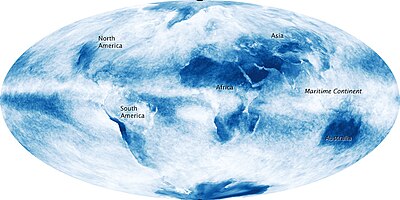User:Towerman/translation/云
气象学上,云是行星表面大气层中由水或多种化学物质构成的可见的液滴或冰晶的集合体。[1]这些悬浮的颗粒物也被称作气溶胶,被气象学的分支云物理学所研究。
地球上的云的形成是地球大气中的空气因两种过程而饱和的结果:空气的冷却和水汽的增加。当饱和度足够,降水将形成并下落到地表;幡状云是个例外,降水在到达地表前就被蒸发了。[2]
In Earth's atmosphere, the international cloud classification system is based on the fact that these aerosols in their most basic forms can show free-convective upward growth into heaps of cumulus, appear in non-convective layered sheets such as stratus, or take the form of thin fibrous wisps of cirrus. Prefixes are used whenever necessary to express variations or complexities in these basic forms or to specify middle or high altitude ranges. These include strato- for low cumulus layers with limited convection that show some stratus-like characteristics, cumulo- for complex highly-convective storm clouds, nimbo- for thick layers of some complexity that can produce moderate to heavy precipitation, alto- for middle, and cirro- for high clouds. Cloud types prefixed by altitude range may be of simple or moderately complex structure. Whether or not a cloud is low, middle, or high level depends on the altitude range of its base above Earth's surface. Layers or heaps with significant vertical extent can form in the low or middle altitude ranges depending on the moisture content of the air.
Clouds in the troposphere, the atmospheric layer closest to Earth's surface, have Latin names due to the universal adaptation of Luke Howard's nomenclature. It was introduced in December 1802 and became the basis of the modern classification system. Synoptic surface weather observations use code numbers to record and report any type of tropospheric cloud visible at scheduled observation times based on its height and physical appearance.
While a majority of clouds form in Earth's troposphere, there are occasions when they can be observed in the stratosphere and mesosphere. These three main atmospheric layers are collectively known as the homosphere. Above this lies the thermosphere and exosphere, which together make up the heterosphere that marks the transition to outer space. Clouds have been observed on other planets and moons within the Solar System, but, due to their different temperature characteristics, they are composed of other substances such as methane, ammonia, and sulfuric acid.
对气候的影响
编辑
云在天气和气候中的角色是预测全球变暖时的主要不确定性之一。[3]和云有关的过程的脆弱的平衡,以及从毫米到行星的大范围的尺度跨度会造成这种不确定性。因此,全球气候模式很难准确描述大尺度天气和云之间的相互作用。前面章节列出的云的复杂性和多样性增加了模拟的难度。一方面,白云顶部对来自太阳的短波辐射会有反射,从而使得地表冷却。另一方面,大多数到达地面的阳光被地面吸收,加热了地表,地表又会向上发射长波的红外的辐射。但是云中的水对长波辐射是有效的吸收剂。云又接着会向上和向下发射红外辐射,向下的辐射会导致地表的净加热效果。这个过程和温室气体和水汽的温室效应类似。
高层的对流层云(例如卷云)的二重效应(短波反射造成的冷却和长波温室升温效应)会随着云量的增加而相互抵消或是产生微小的净加热效果。这种短波反射效应在中层云和低层云(例如高积云和层积云)中占了主要部分,从而造成几乎没有长波效应和净的冷却效果。很多研究已经开始关注低层云对变化的气候的相应。不同的最先进的全球气候模式对云的模拟可能会产生相当不同的结果,有些显示增加的低层云,有些则得到低层云的减少。[4][5]
极地平流层云和中层云不太常见,它们的分布不够对气候产生重要的影响。但是,夜光云出现频率自19世纪以来逐渐增加可能是气候变化的结果。[6]
全球亮化
编辑最近的研究显示了全球亮化的趋势。[7]虽然造成这一趋势的原因还没有能被完全理解,但全球黯化(和后来的逆转)被认为是由大气中气溶胶(特别是生物质燃烧和城市污染带来的含硫气溶胶)含量的变化所引起的。[8]气溶胶含量的变化还可能通过改变云滴的尺寸分布[9]或是云的降水特性和寿命[10]而产生对云的间接效应。
地外行星
编辑在太阳系中,任何有大气层的行星或卫星都会有云。金星的厚厚云层是由二氧化硫构成的。火星有很高很薄的水冰云。木星和土星都有一个外层的由氨气云构成的云盖,中间层是硫化铵云盖,里层是水云盖。[11][12]土星的卫星土卫六上的云被认为主要是由甲烷构成。[13]卡西尼-惠更斯号的土星任务发现了土卫六上存在着液体循环的证据,比如极地附近的湖泊和星球表面的河流冲刷成的沟槽。天王星和海王星的多云的大气中主要是水汽和甲烷构成。[14][15]
参考文献
编辑- ^ Weather Terms. erh. [21 June 2013].
- ^ Weather terms. erh. [21 June 2013].
- ^ D. Randall, R. Wood, S. Bony, R. Colman, T. Fichefet, J. Fyfe, V. Kattsov, A. Pitman, J. Shukla, J. Srinivasan, R. Stouffer, A. Sumi, and K. Taylor (2007) "Climate models and their evaluation" in S. Solomon, D. Qin, M. Manning, Z. Chen, M. Marquis, K. Averyt, M.Tignor, and H. Miller (eds.) Climate Change 2007: The Physical Science Basis. Contribution of Working Group I to the Fourth Assessment Report of the Intergovernmental Panel on Climate Change. Cambridge University Press, Cambridge, United Kingdom and New York, NY, USA.
- ^ S. Bony and J.-L. Dufresne. Marine boundary layer clouds at the heart of tropical cloud feedback uncertainties in climate models (PDF). Geophysical Research Letters. 2005, 32 (20). doi:10.1029/2005GL023851.
- ^ B. Medeiros, B. Stevens, I.M. Held, M. Zhao, D.L. Williamson, J.G. Olson, and C.S. Bretherton. Aquaplanets, Climate Sensitivity, and Low Clouds. Journal of Climate. 2008, 21 (19): 4974. doi:10.1175/2008JCLI1995.1.
- ^ Kenneth Chang. Caltech Scientist Proposes Explanation for Puzzling Property of Night-Shining Clouds at the Edge of Space. 2008-09-25 [2012-03-13].
- ^ Martin Wild, Hans Gilgen, Andreas Roesch, Atsumu Ohmura, Charles N. Long, Ellsworth G. Dutton, Bruce Forgan, Ain Kallis, Viivi Russak, and Anatoly Tsvetkov. From Dimming to Brightening: Decadal Changes in Solar Radiation at Earth's Surface. Science. 2005, 308 (5723): 847–50. PMID 15879214. doi:10.1126/science.1103215.
- ^ Costantino, L. and F.-M. Bréon. Analysis of aerosol-cloud interaction from multi-sensor satellite observations. Geophysical Research Letters. 2010, 37 (11): n/a. doi:10.1029/2009GL041828.
- ^ S. A. Twomey. Pollution and the planetary albedo. Atmospheric Environment (1967). 1974, 8 (12): 1251. doi:10.1016/0004-6981(74)90004-3.
- ^ B. Stevens and G. Feingold. Untangling aerosol effects on clouds and precipitation in a buffered system. Nature. 2009, 461 (7264): 607–13. PMID 19794487. doi:10.1038/nature08281.
- ^ A.P. Ingersoll, T.E. Dowling, P.J. Gierasch, G.S. Orton, P.L. Read, A. Sanchez-Lavega, A.P. Showman, A.A. Simon-Miller, A.R. Vasavada. Dynamics of Jupiter’s Atmosphere (PDF). Lunar & Planetary Institute. [2007-02-01].
- ^ Monterrey Institute for Research in Astronomy. Saturn. 2006-08-11 [2011-01-31].
- ^ Athéna Coustenis and F.W. Taylor. Titan: Exploring an Earthlike World. World Scientific. 2008: 154–155. ISBN 978-981-270-501-3.
- ^ Jonathan I. Lunine. The Atmospheres of Uranus and Neptune. Annual Review of Astronomy and Astrophysics. 1993-09, 31 (1): 217–263 [2019-06-25]. ISSN 0066-4146. doi:10.1146/annurev.aa.31.090193.001245 (英语).
- ^ Linda T. Elkins-Tanton. Uranus, Neptune, Pluto, and the Outer Solar System. New York: Chelsea House. 2006: 79–83. ISBN 0-8160-5197-6.
云(62319) en:cloud User:Towerman/translation/云(30714)